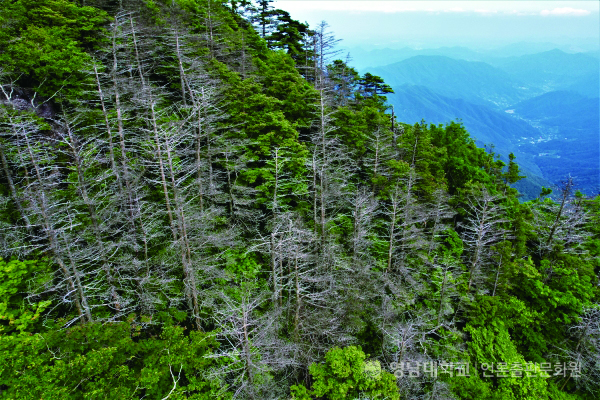
Have you ever read the book called The Giving Tree? It is the story of a tree that gives everything to satisfy the greed and happiness of a human. Something else likely to appear only in literature happened in 2021.
Many people have loved Mount Jiri as a tourist destination and hiking route. However, it is becoming a ‘tree cemetery’. A mass death phenomenon is taking place in the forest habitat of a group of coniferous trees between 1,600 and 1,900 meters above sea level. Compared to Mount Jiri in the past, there are obvious color differences.
Rapid climate change and global warming are considered to be critical factors in the recent mass death phenomenon. Initially, the alpine belt in Korea is a low-temperature zone with coniferous communities over 1,500 meters above sea level. However, the average temperature has risen due to abnormal weather conditions, and the amount of snow has decreased, resulting in harm to conifer growth. Park Hong-chul, a researcher at the National Park Institute, said that “The trees in Mount Jiri begin to grow between April and early May. Because of the lack of moisture, the biological error occurred.”
It is estimated that there are 54,000 dead conifers in Mount Jiri. In severe cases, the rate of withering is more than half. Significantly, the number of dead trees in Cheonwangbong Peak has increased more than five times in 10 years. The coniferous trees of the Mount Jiri alpine belt fall as the leaves turn brown. After that, the bark cracks, leaving only grayish, thin branches.
A Korean fir, well-known as the Christmas tree, is a native species that lives only in the hilly sections above 1,000 meters. It is known to live only in southern regions such as Mount Jiri and Mount Halla. Since 2000, in the aftermath of the climate crisis, the population of Korean firs has been decreasing. The International Union for Conservation of Nature designated the species as endangered in 2013. However, despite this trend, it is not yet an endangered species in Korea because of its large population.
The challenge we need to solve is to preserve the remaining forest. Experts say that the mountain can be maintained for the next 100 years if it is managed ten years ahead. It is time to come up with some measures to preserve the environment.


